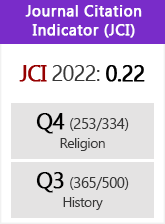The idea of tashabbuh in sufi communities and literature of the late 6th/12th and early 7th/13th century in Baghdad
DOI:
https://doi.org/10.3989/alqantara.2011.v32.i1.253Keywords:
Mutashabbih, rukhṣa, ribāṭ, khādim, qalandariyya, samāʻ, takallufAbstract
The aim of this paper is to focus attention on the role of the mutashabbih within the active life of ribāṭ in sixth/twelfth and early seventh/thirteenth century Sufism of late Abbasid Baghdad with its basic source being Abū Ḥafṣ al-Suhrawardī´s ʻAwārif al-maʼārif. Other concepts and groups are also analyzed such as qalandariyya, majḏhūbs, takalluf, which is the semblance of ecstasy during samāʻ, and the ambiguous status of khādim. The broad category khādim, according to al-Suhrawardī seems to have included types of affiliation and function in Sufi collective life that went beyond the specific position of the khādim as a senior disciple of a particular Sheikḥ. The infinitive form khidma would probably have implied categories ranging from a transitory affiliation motivated by some expenditure on the Sufis, through a more robust one in which the same title might designate those who occasionally visited resident Sufis and participated in one or more of their rituals, and on to actual residence of such “servants” in the ribāṭ. Al-Suhrawardī tashabbuhtheory is based on the essential purpose of creating a popular Sufi system open to one and all, with an inherent dynamic that leads ultimately to the rank of Sheik-hood (mashyakha).
Downloads
Download data is not yet available.
Downloads
Published
2011-06-30
How to Cite
Salamah-Qudsi, A. S. (2011). The idea of tashabbuh in sufi communities and literature of the late 6th/12th and early 7th/13th century in Baghdad. Al-Qanṭara, 32(1), 175–197. https://doi.org/10.3989/alqantara.2011.v32.i1.253
Issue
Section
Articles
License
Copyright (c) 2011 Consejo Superior de Investigaciones Científicas (CSIC)

This work is licensed under a Creative Commons Attribution 4.0 International License.
© CSIC. Manuscripts published in both the printed and online versions of this Journal are the property of Consejo Superior de Investigaciones Científicas, and quoting this source is a requirement for any partial or full reproduction.All contents of this electronic edition, except where otherwise noted, are distributed under a “Creative Commons Attribution 4.0 International” (CC BY 4.0) License. You may read here the basic information and the legal text of the license. The indication of the CC BY 4.0 License must be expressly stated in this way when necessary.
Self-archiving in repositories, personal webpages or similar, of any version other than the published by the Editor, is not allowed.














